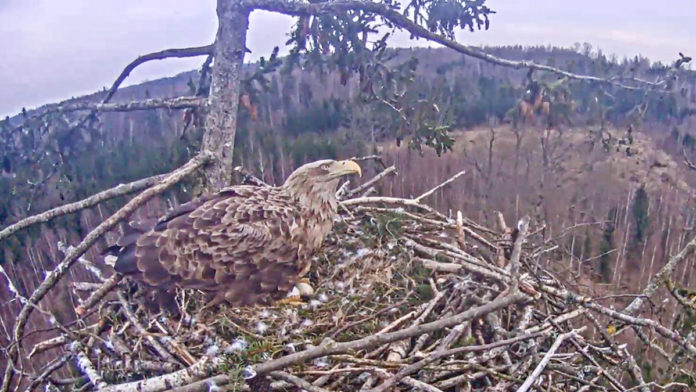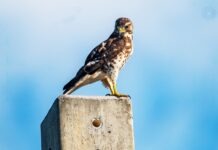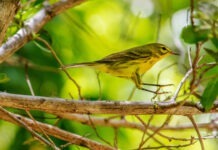Certain aspects of your life are hard to explain. For instance, I would not want to answer to a jury of my peers why I wasted so much time last week staring slack-jawed at the drama taking place in a pine tree in Eastern Europe. I’ll start by blaming Davis.
He’s Latvian, and the kind of friend who, if you call him up, tell him you’re making a movie for a 72-hour film challenge, and ask him to put on a Grim Reaper costume, run around the beach and try to catch a football that he can’t see, he’ll do it, no questions asked.
A few years ago, Davis sent me a link to a webcam that’s mounted on a white-headed eagle’s nest in Latvia. It was nice of him to think of me, though nest cams can often be rather boring. But I clicked to be polite.
The nest was in a tree that towered above all the other trees in a Latvian forest. The white-tailed eagle who sat on it looked a lot like our bald eagle, but with a mousy, light-brown head instead of a white (bald) head. According to the commentary, a mix of English, Russian and Latvian, this was the female, Milda, named for the goddess of peace.
There wasn’t much action on screen. Sometimes her feathers would rustle in the breeze. Sometimes she moved her head to look around. But I liked the sound.
I’ve never been diagnosed with ADD, but I have my suspicions. The slightest distraction can send my brain tearing down the road like a dog that snapped its leash. Music can quell my neurological wanderlust — unless it’s too boring or too engaging.
The Latvian eagle cam was just a damn pleasant stream of real-life ambient noise — a soothing soundtrack of distant bird calls and gentle breezes. I listened to it often. OK, a lot.
Milda’s mate was called Raimis. Apparently you could tell them apart by the spots on their tails. Like most eagles, the parents seemed to be sharing the work. They’d been together on the same nest since 2017.
Eventually I started to recognize their calls. The staccato, close-to-the-mic would be the one on the nest saying, “Hey, I’m tired of sitting on these eggs. Come take your shift.” The distant stuttering bark meant one of them was coming back to the nest. If I acted quickly, I could click over and watch a small dot on the screen grow to a full-sized, 10-pound bird of prey that would land in an impossibly deft manner on the edge of the nest.
But when I tuned in last week for a little Latvian nature zen, something had changed. Milda was on the nest, crouched over her three eggs, giving a low, plaintive call. I know we shouldn’t assign human emotions to animals, but it was hard to take it as anything other than despair.
I headed to the comments.
Raimis, the male, had been gone for two days.
Some commenters were hopeful that Raimis was out there somewhere, injured or trapped, heroically trying to get back to Milda. Some thought he was dead, or too gravely injured to return.
The eagle’s absence was alarming and significant, not so much as a love story (though one was being written in the comments), but as a biological roadblock.
A single eagle is unable to fledge one chick on its own, let alone three. She had to eat, but leaving the nest left it vulnerable to predation. Owls, crows, other eagles — any of them could take out a clutch in minutes.
If the eggs did hatch, she would need to spend even more time away from the nest, hunting for her hungry, but vulnerable chicks. A crow or a heron might swallow them whole. An owl might drag one off in his talons to feed it piecemeal to his own offspring.
Most of the knowledgeable folks were convinced that in a day or two, when the hunger built, she would abandon the nest, fly off and live to breed another year. It’s what eagles always did.
I kept checking the cam even after the sun set and the screen turned to dark digital static. But she stayed, steadfast.
She didn’t leave the next day, or the day after that, or that week even.
On the eighth day, though, she did leave, but returned six hours later with a full crop, having eaten. She hunkered down again.
There was more debate. Were the eggs even viable after so many hours unbrooded? How could this not end tragically?
Villains appeared – two other eagles who wanted the nest site. They would circle overhead, yelling, and she would yell back, firing her resolve up at them like an ack-ack gun. Once in a while one of them would land in a branch above the nest and try to menace her, though they would never go in for a physical attack, as female eagles can be 20-25% bigger than males. They would no doubt get their asses kicked. Hours would be spent in a Latvian standoff.
People started demanding that the Latvian Fund for Nature, which runs the camera, do something. Have someone climb up the tree to feed her. Send food up with a drone. The knowing folks patiently explained why that was a bad idea.
More things have happened than I have space to describe here. Windstorms. Snow. Other interlopers.
Still, Milda sits there, probably no longer expecting Raimis to return, but unwilling to give up until she has to, and maybe not even then.
You can view the Latvian Fund for Nature’s white-tailed eagle nest cam at: markhedden.com/eagle






















